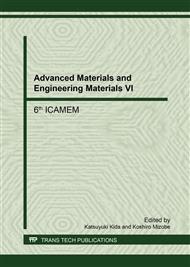[1]
P.S. Mangat, B.T. Molloy. Prediction of long term chloride concentration in concrete. Materials and structures, 1994, 27(6): 338-346.
DOI: 10.1007/bf02473426
Google Scholar
[2]
A. Costa, J. Appleton. Chloride penetration into concrete in marine environment-Part II: Prediction of long term chloride penetration. Materials and Structures, 1999, 32(5): 354-359.
DOI: 10.1007/bf02479627
Google Scholar
[3]
P.A.M. Basheer, R.J. Andrews, D.J. Robinson, et al. PERMIT, ion migration test for measuring the chloride ion transport of concrete on site. NDT & E International, 2005, 38(3): 219-229.
DOI: 10.1016/j.ndteint.2004.06.013
Google Scholar
[4]
M. Maage, S. Helland, E. Poulsen, et al. Service life prediction of existing concrete structures exposed to marine environment. ACI Materials Journal, 1996, 93(6): 602-608.
DOI: 10.14359/9866
Google Scholar
[5]
P.B. Bamforth, W.F. Price. Factors influencing chloride ingress into marine structures. publicación presentada en Economic and durable construction through excellence, Dundee, UK, (1993).
Google Scholar
[6]
S.K. Kaushik, S. Islam, Suitability of sea water for mixing structural concrete exposed to a marine environment. Cement and Concrete Composites, 1995, 17(3): 177-185.
DOI: 10.1016/0958-9465(95)00015-5
Google Scholar
[7]
H. E. D. H. Seleem, A. M. Rashad, & El-Sabbagh, B. A. (2010). Durability and strength evaluation of high-performance concrete in marine structures. Construction and building Materials, 24(6), 878-884.
DOI: 10.1016/j.conbuildmat.2010.01.013
Google Scholar
[8]
S. Kumar, Influence of water quality on the strength of plain and blended cement concretes in marine environments. Cement and Concrete Research, 2000, 30(3): 345-350.
DOI: 10.1016/s0008-8846(99)00263-x
Google Scholar
[9]
H. Z. Lopez-Calvo, et al. Compressive strength of HPC containing CNI and fly ash after long-term exposure to a marine environment., Cement and Concrete Composites 34. 1 (2012): 110-118.
DOI: 10.1016/j.cemconcomp.2011.08.007
Google Scholar
[10]
W. Müllauer, R. E. Beddoe, D. Heinz, Sulfate attack expansion mechanisms. Cement and concrete research, 2013, 52: 208-215.
DOI: 10.1016/j.cemconres.2013.07.005
Google Scholar
[11]
C. Yu, W. Sun, K. Scrivener, Mechanism of expansion of mortars immersed in sodium sulfate solutions. Cement and concrete research, 2013, 43: 105-111.
DOI: 10.1016/j.cemconres.2012.10.001
Google Scholar
[12]
S. O. Ekolu, M. D. A. Thomas, R. D. Hooton, Pessimum effect of externally applied chlorides on expansion due to delayed ettringite formation: Proposed mechanism. Cement and concrete research, 2006, 36(4): 688-696.
DOI: 10.1016/j.cemconres.2005.11.020
Google Scholar
[13]
E. Rozière, A. Loukili, R. El Hachem, et al., Durability of concrete exposed to leaching and external sulphate attacks. Cement and Concrete Research, 2009, 39(12): 1188-1198.
DOI: 10.1016/j.cemconres.2009.07.021
Google Scholar
[14]
B. Bary, N. Leterrier, E. Deville, et al. Coupled chemo-transport-mechanical modelling and numerical simulation of external sulfate attack in mortar. Cement and Concrete Composites, 2014, 49: 70-83.
DOI: 10.1016/j.cemconcomp.2013.12.010
Google Scholar
[15]
R. El-Hachem, E. Rozière, F. Grondin, et al., New procedure to investigate external sulphate attack on cementitious materials. Cement and Concrete Composites, 2012, 34(3): 357-364.
DOI: 10.1016/j.cemconcomp.2011.11.010
Google Scholar
[16]
R. S. Gollop, H. F. W. Taylor, Microstructural and microanalytical studies of sulfate attack. I. Ordinary Portland cement paste. Cement and Concrete Research, 1992, 22(6): 1027-1038.
DOI: 10.1016/0008-8846(92)90033-r
Google Scholar
[17]
J.S. Zhang, Y. H. Zhang, L. P. Feng, Corrosion Resistant Coefficient for Concrete Compressive Strength under Sulfate Environment, Journal of Building Materials, 2014, 17(3).
Google Scholar
[18]
L. Li, Experiment on Durability of MSFAC Long-term Steeped in Sodium Sulfate Solution, North China University of Water Resources and Electric Power, (2011).
Google Scholar
[19]
G. X. Yu, Research on the Sulfate Corrosion Performance of Concrete under the Effect of Multi-Factor Coupling, China University of Mining and Technology, (2014).
Google Scholar
[20]
P. K. Mehta, H. H. Haynes, Durability of concrete in seawater. Journal of the Structural Division, 1975, 101(ASCE# 17516 Proceeding).
Google Scholar
[21]
J. G. Wiebenga, Durability of concrete structures along the North Sea coast of the Netherlands. Special Publication, 1980, 65: 437-452.
Google Scholar
[22]
S. Islam, M. Islam, B. C. Mondal, DETERIORATION OF CONCRETE IN AMBIENT MARINE ENVIRONMENT (RESEARCH NOTE). International Journal of Engineering-Transactions B: Applications, 2012, 25(4): 289.
Google Scholar
[23]
S. Kumar, Influence of water quality on the strength of plain and blended cement concretes in marine environments. Cement and Concrete Research, 2000, 30(3): 345-350.
DOI: 10.1016/s0008-8846(99)00263-x
Google Scholar
[24]
M. Santhanam, M. Cohen, J. Olek, Differentiating seawater and groundwater sulfate attack in Portland cement mortars. Cement and Concrete Research, 2006, 36(12): 2132-2137.
DOI: 10.1016/j.cemconres.2006.09.011
Google Scholar
[25]
O. S. B. Al-Amoudi. Durability of plain and blended cements in marine environments. Advances in Cement Research, 2002, 14(3): 89-100.
DOI: 10.1680/adcr.14.3.89.38281
Google Scholar
[26]
M. A. Bader, Performance of concrete in a coastal environment. Cement and Concrete Composites, 2003, 25(4): 539-548.
DOI: 10.1016/s0958-9465(02)00093-8
Google Scholar
[27]
R. B. Polder, J. A. Larbi, Investigation of concrete exposed to North Sea water submersion for 16 years. Heron, 1995, 40(1).
Google Scholar
[28]
T. U. Mohammed, H. Hamada, T. Yamaji, Performance of seawater-mixed concrete in the tidal environment. Cement and concrete research, 2004, 34(4): 593-601.
DOI: 10.1016/j.cemconres.2003.09.020
Google Scholar
[29]
I. Teruki, Durability Investigation (Corrosion, Salt Damage) of the Waterway that has been in Service under the Marine Environment. Proceedings of the Japan Concrete Institute, 1987, 9(1): 435-438.
Google Scholar
[30]
F. Lu, Research on the Identification Coefficient of Relational Grade for Grey System, System Engineering Theory and Practice, 1997, 6: 50-55.
Google Scholar


